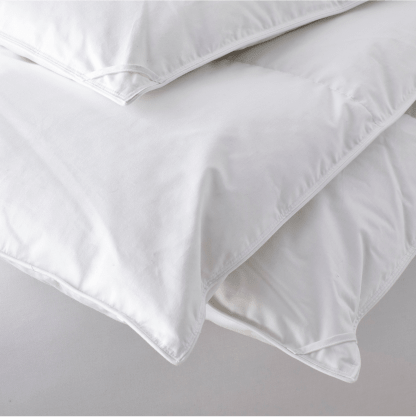
Two Ways to Put on a Duvet Cover
Swapping out bedding doesn’t seem like a challenge—but even when you think you know how to put on a duvet cover, you can run into obstacles. Duvet inserts that bunch, duvet covers that slip, an unwieldy mess that won’t cooperate…we know, we’ve been there. Don't sweat it, you're not the only one looking for easy directions to solve these duvet cover challenges—we promise.
By following some expert tips, you can easily change a duvet cover by yourself, or keep the insert snug and in place inside the cover. Check out our two employee-approved techniques below.
Method One
The Traditional Method

With this method, it’s easy to think of the duvet cover as a big pillowcase that needs to fit over the comforter. It’s less like stuffing the duvet insert up into the cover, and more like pulling the cover down around the insert, then fluffing the whole thing at the end.
At The Company Store, our duvet inserts offer corner loops, while our duvet covers are equipped with ties in the inside corners. Together, these loops and ties keep the duvet insert from slipping inside the cover. (If your duvet insert and cover don’t have loops and ties, you can sew them in. Don’t worry if your sewing isn’t neat; they won’t be visible from the outside.)
Traditional Method
Method Two
The Roll Method

The description may look puzzling and complex, but rest assured: The Roll Method of changing a duvet cover works like a charm, and it isn’t hard to do. People who favor this method find it easier and faster than the Traditional Method and say it requires less moving, bending, and tugging.
The two basic steps are to “roll it in” and “roll it out.” You’ll begin by turning the duvet cover inside-out and rolling it up with the duvet insert or comforter. Then you’ll perform a simple maneuver to unroll the bundle, magically leaving the comforter inside the cover.
Roll It In
Roll It Out
Give both methods a try. The Traditional Method tends to make sense right away, but many people who try the Roll Method find themselves converts.
Once you know how to change duvet covers easily by yourself, you won’t mind the job at all. You might decide to simplify your daily bed-making by using only a duvet cover, not a top sheet or blanket beneath it—it’s a snap to pull up in the morning, and you can take off the cover and toss it in the laundry with the fitted sheet each week. Or you might just appreciate the ability to easily update your room—switching to a seasonal, splashy, or soothing patterned duvet cover when the mood strikes, or swapping to cozy flannel during a cold snap.


